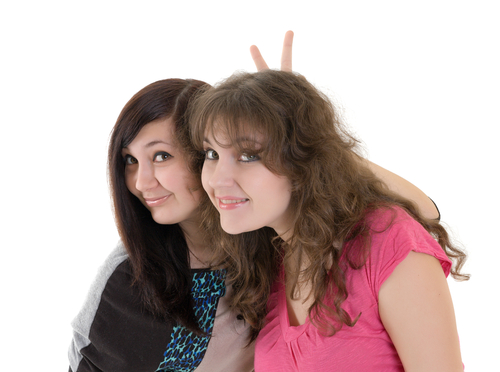Relationship Coach Matt Townsend points out five small areas that can have a big impact on communication.
Humans are born to communicate. Whether it’s our posture, tone, inflection, facial expressions or the words we’re actually saying, humans truly cannot, not communicate. Research shows that the number one issue, over which couples complain when seeing a marriage counselor, is communication. Over the years, I’ve found non-verbal communication skills can be some of the most difficult communication to sort through. There are five non-verbal communication behaviors that are known to communicate more closeness or unity in the relationship. Those five behaviors, also known as immediacy behaviors are: positive facial expressions (smiling), touching, proximity and closeness, open body positioning and eye contact. Let’s take look at each of these behaviors and learn some tools to communicate more love non-verbally.
Positive Facial Expressions (Smiles)
Your partner’s face is usually the best barometer of their emotional health. For example think of how quickly a smile, frown, yawn, wink or raised eyebrows can communicate information. We are always monitoring the facial expressions as a person is talking and we adjust our interpretations accordingly. Facial expressions are the universal language of mankind. Every face in the world has been designed to convey the same feelings through the same facial expressions. If someone feels pain in Argentina, they will have the same facial expressions as a person in Utah or Uganda. If someone is surprised by their partner, that surprised emotion is immediately manifested through the muscles in their face and communicated to their partner, the exact same way world wide. Research in the field of non-verbal communication and facial expressions show that some parts of the face are more revealing than others. For example our eyes can reveal happiness or sadness, and even surprise. Our mouth and lips can reveal happiness, surprise, a smile or a frown. All of which will demonstrate our state of friendliness. Your eyebrows and forehead can also reveal signs of anger, frustration or surprise. In your marriage, wouldn’t you be much more excited to come home to a face that is emoting positive information?
In my book, the most positive facial expression known to man is the smile. It is the universal sign that you are approachable, safe, and happy. If you were on the streets of a foreign country and needed directions to a hotel, what kind of facial expressions would you look for? How would you know who to approach and who to trust? Now ask yourself, what is it like to come home to you? What do your facial expressions communicate about you?
Challenge: Smile more at your partner and try throwing in a wink now an then.
Touch
The distance that you stand, talk, and sleep from another person conveys a non-verbal message. Physical touch can include a variety of things like handshakes, holding hands, kissing (cheek, lips, and hand), back slapping, high fives, a pat on the shoulder, and brushing an arm. Physical contact itself can convey your level of feeling toward each other and/or your lack of attraction for one another. The power of touch, when used properly can create a more direct message to your partner than thousands of words ever could. One powerful touch is reciprocity, meaning I touch you and you touch me back. It is a sign of unity and togetherness. It is communicating that we’re on the same page. If I touch you and you don’t reciprocate, then it communicates something completely different. Touch can convey not only content but also emotion and intensity as well. It is a very effective form of non-verbal communication.
Challenge: Make a conscious effort to touch your partner more. When your partner touches you, touch him or her back.
Open Body Positions
So think about what this communicates. You’re sitting on the couch watching TV with your partner and somehow the topic about the last family party comes up. You were hurt because your spouse said embarrassing things to their family and you wanted to give you partner some “overdue” feedback about how you felt. The minute you begin talking about your pain you see that your spouse turns their body away from you so it feels like you’re now really just talking to their shoulder. They cross their arms and legs and shake their head from left to right. They lean their head back on the couch and begin to look at the ceiling. What are they saying? Not good right?
Our body position is a wonderful signal if our partner is open to the relationship, topic or person. Do you face your partner when you’re talking? An excellent example of a welcoming open body position would be a partner throwing their arms wide open gesturing to their partner they’re ready for a hug. When you’re in bed do you face your partner or do you immediately roll over with your back to your partner and pull the covers down tightly to seal you in your cocoon?
Other signs of open body positions might be if you’re tilting your head slightly to one side or the other, or slightly leaning forward toward your partner when you’re talking or facing each other. Take a second and think back to the first time you kissed your partner. What was it that told you it was safe for you to attempt such a risky feat? I’ll bet your body positions were communicating that you were both ready for the kiss. Odds are you were both in each other’s private space about one foot away from each other. You’re bodies were square to each other, you’re arms were open and around each other. When you had the idea to “make the move” you looked deeply into their eyes and they looked deeply back, they leaned in closer and you leaned right back, you kissed them gently and they kissed you right back. You’re bodies were subtly mirroring each others actions and reciprocity abounded.
Now, imagine how quickly the mood would have changed had one of you leaned away from your partner’s advancement. What if your partner had pulled their arms in from around your waist creating an obstacle between you? Or what if they had just turned their body away from you about 90 degrees. It totally changes the mood doesn’t it? Remember that your body will always give away the intentions of your heart.
Challenge: As your partner talks to you, position your body to be open to him or her. Turn toward your partner as they speak and lean in to show you’re really paying attention.
Proximity and Closeness
Your “personal space” is the little imaginary “bubble” that each of us has placed comfortably around us. It’s our place where we feel safe and secure in our interactions with others. Many times we don’t even notice the bubble until it has been popped by someone behind you at the check out stand or ATM machine, who keep “inching” into “our space.” Proximity and closeness as non-verbal communication is always in play in our closest relationships. In some cultures the closer you stand the more attracted you are to the person. For example, have you noticed how important it is where your partner chooses to sit at a party in relation to you? How would you feel attending your wife’s work party if she chose to sit with her co-workers while you sat alone on the couch? The space we chose to give someone and the closeness in which we interact demonstrates to our partner and to everyone else around, our commitment and comfort levels with each other. You may have noticed in your own relationships when things aren’t going well, you naturally pull yourself away physically, creating distance from your partner. In fact many couples make a claim when they are separating that they just need “some space” to think things through.
In our most intimate relationships our personal space is constantly in play and for some, this is a major cause of stress. The irony of being in close proximity can not be overstated. Nothing can be more comforting than feeling the closeness of your partner who feels so safe with you that they share everything in their lives with you like their bed, the couch, the shower, their germs or even the same utensils or cup. Yet sometimes, all of this closeness and familiarity has us yearning to have some space to ourselves.
Generally speaking, men and their independent nature are much more inclined to feel smothered in a relationship and to make requests for their own space, a request that many times can seriously scare their partner. Some examples of these more frustrating moments might be when a husband is working out of his home office and notices that some important files have been moved or that his stapler is missing and he feels violated. A wife might feel frustrated when while trying to shower or change her clothes her husband is constantly interrupting or watching her. The act of sharing personal space and proximity can be both a powerful communication tool and at times a difficult line to walk. Remember though, your proximity and closeness to your partner is major sign of love. In fact, back in the old days when the seat belts weren’t mandatory and our automobiles all had long bench seats, couples would do anything they could to closes the gap of space between them, even if it made it harder to get in and out of the car.
Challenge: Close the gap every chance you get by standing and sitting closer to your partner.
Eye Contact
For me eye contact is one of the best sources of non-verbal communication because the eyes truly are the “window” to the soul of your partner. Do you remember back in the day when you two first fell in love and you couldn’t stop looking into each others eyes? Do you remember when you would say something as corny as “Every time I look into your eyes I swear I see heaven”? Cheesy! Well when people feel safe with someone, they are more inclined to connect eye to eye.
The some of the latest studies about non-verbal communication researchers found that the person who usually has more power in the relationship generally maintains eye contact longer than the person who feels they have less power. Test this theory out and take a second to catch your partner’s gaze. See which of you can hold your gaze the longest and you may end up learning who perceives themselves to have more power in the relationship. You may have noticed that youth and younger children generally will maintain less eye contact with adults for the same reason.
The frequency of eye contact may also communicate important information about your relationship. For example frequent eye contact can demonstrate certain levels of interest, attention, and involvement with each other, like when you were first dating and couldn’t take your eyes off each other. An aversion to looking at your partner might be signaling a sense of displeasure or disgust with the person, like when you divert your head away during an unpleasant or violent scene in a movie. When your partner’s eyes look downward that sign is usually associated as a show of modesty, where eyes rolled upward are signs of fatigue, like when your teenage daughter rolls her eyes to the back of her head because she’s tired of hearing you say that “she needs to study more and socialize less!”
One of the most obvious non-verbal signs we make with our eyes might be a simple wink of the eye or lift of their brow to show your partner that you’re really into them. In fact, with many of the couples I work with their eyes are the most obvious sign that the marriage is in trouble. Usually one partner will say something like “I just want you to look at me like you used to.”
Challenge: Maintain more eye contact with your partner. Specifically set time aside each day to connect with your partner by looking deeply into each others eyes.
Matt can be reached at the Townsend Relationship Institute or online at marriagemattersutah.com.
Matt also frequently has Date Night workshops. The next one is:
Date Nights with Matt Townsend
Friday, November 12
“The 7 Basic Needs of Every Relationship”
Location: Noah’s in South Jordan
Saturday, November 13
“The 5 Biggest Thinking Errors”
Location: Horizon Financial Center
$35 per couple
To register call 801-747-2121















Add comment